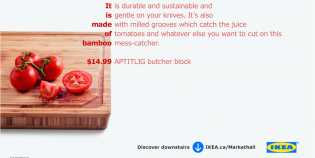At a gas station somewhere in Canada, a man walks solemnly up to the counter and opens a briefcase stuffed with stacks of bills. The clerk smiles knowingly, and the man departs the gas station without a word, leaving the briefcase behind. It’s the kind of scene that conjures up organized crime, the completion of a drug buy or simply a transaction between financial heavyweights who prefer to deal in cash.
But it’s actually a car commercial for Hyundai, touting its fuel-efficient line of vehicles. Almost every viewer will immediately get the joke, although it’s more likely to induce a grimace than a smile. The unspoken punchline: Rising gas prices are forcing Canadians to dig deep into their wallets.
Fuel prices have been trending upward for years, of course, but the past few months have brought an unusually sharp spike—to a record-high $1.40 per litre this summer—and it seems as though people are no longer able to absorb the impact through gritted teeth. Environmental enlightenment, the focus of so much media attention and marketing in the past couple of years, may have encouraged Canadians to rethink their consumption habits, but triple-digit gas has been the catalyst for more concrete change. A new kind of consumer has arrived, one whose transportation, travel and shopping choices are motivated in large part by a need to offset high fuel costs. Marketers will have to find new ways to speak to them.
After all, there is little indication that gas prices will return to what was once considered normal. “China’s going to keep drinking it, India’s going to keep drinking it and it’s going to go up again,” says Alan Middleton, assistant professor of marketing at York University in Toronto. “People have finally bought into the fact that they’re going to have to change their behaviour.”
No sector has felt the effects as severely—or as suddenly—as the automotive industry. Sales by new car dealers were down 3.1% in June, representing a fifth consecutive month of decline, which Statistics Canada attributes primarily to a drop in truck and SUV sales. Small is the next big thing for gas-conscious consumers, and automakers have responded by making fuel efficiency the centre of their messaging.
Take the Hyundai commercial, for example, one of dozens of car ads highlighting the issue of fuel economy that have debuted in recent months. Or the fact that almost every advertisement in the automotive sections of Canada’s newspapers refers, with varying levels of directness, to the cost of gas: General Motors claims to have the largest fleet of vehicles that get seven litres per 100 kilometres or better. Toyota is promoting a sales event by urging consumers to “Go further. Save money. Drive cleaner. Be happy.” Kia and Nissan are offering gas cards with purchase ($500 in Kia’s case and a 20%-per-litre discount for one year from Nissan).
Fuel economy “really has become one of the top three purchase reasons in almost every single vehicle category. It used to be that the monthly payment was the key indicator,” says Dean Stoneley, vice-president of marketing for Ford, whose late summer ad campaign hinged on the tag line “Go further in a Ford.”
Ford’s new ad strategy involves more than just explicit gas-related messaging. Stoneley says the company is also being more thoughtful about which cars to advertise, and how. Ford’s current major media advertising emphasizes the smaller, more fuel-efficient vehicles in its fleet, while communication about gas-guzzling trucks and SUVs has gone below the line. “It tends to be more one-to-one marketing [and] direct marketing,” says Stoneley of the shrinking SUV market. “But you won’t see that category on TV.”
Intuitively, consumers know that smaller generally means better in terms of fuel economy, so it’s hardly surprising that BMW’s Mini brand is hot with consumers. Sales in July were up 54% over the same month last year and year-to-date totals are 28% ahead of 2007. Marc Belcourt, brand communications manager at Mini Canada, says that while fuel efficiency has always been a major part of the brand’s messaging, it will become more prominent in this fall’s advertising.
“We will probably see a higher-profile fuel efficiency message appearing [in advertising], whereas before it was a performance or a handling message,” says Belcourt. Although the company has not yet conducted any third-party research into changing purchase factors, anecdotal information from car dealers suggests these are the types of ads that will resonate with consumers. “Fuel price is really the high-profile issue that has gotten people talking about the way they live and what their requirements are for a vehicle,” says Belcourt. “Starting in April and much more visible into May, that was the feedback we got from our retailers—that consumers were much more focused on the fuel efficiency.”
While higher gas prices have given small-car manufacturers a competitive edge, they’ve also been a boon to companies looking to change consumer perception about car ownership in general. The car sharing service Zipcar, for example, has enjoyed a healthy bump in membership—up 11,000 worldwide in July, three times more than the number who joined in July 2007, according to Zipcar Toronto general manager Michael Lende. Surveys conducted by the company indicate that 40% of these new members based their decision on the cost of gas. Lende adds that 40% of Zipcar members either gave up their car or decided not to buy one in their first year of membership.
Lende calls gas prices a “double-edged sword,” given that Zipcar’s vehicles need to be refuelled just like any other. But Zipcar customers are spared the pain of paying directly for gas—when a member steps into one of the 300 Zipcar vehicles in Toronto, for example, they find an Esso gas card billed to the company, so fuelling up doesn’t add to their expenditure.
Zipcar’s marketing, which leans heavily toward community event activation and online advertising, has always spotlighted gas savings, but Lende says current prices have given the message greater resonance among consumers. “The spike in gas prices is really helping to create awareness that there are alternatives to car ownership,” says Lende, who adds that Zipcar customers represent a demographic that is making more sweeping lifestyle changes. “We’re creating a consumer who’s walking more, biking more, taking transit more and is doing something for the environment, even if all they meant to do was save some money.”
The impetus to save money on gas isn’t just affecting the way consumers move around their cities. It’s having an impact on their vacation plans, too. Results of a June survey from the Canadian Tourism Commission found only 52% of Canadians were planning a summer trip, down from 68.9% the previous year. And in August, Angus Reid released results of a poll in which 40% of respondents said they had chosen local tourism over trips abroad in 2008, with 56% saying the cost of gas had affected their travel decisions.
It’s a consumer insight that tourism organizations have been quick to capitalize on. Earlier this year, for instance, Travel Alberta launched a campaign encouraging people in British Columbia, Saskatchewan and Alberta to check out the province. Derek Coke-Kerr, managing director at Travel Alberta, says the $5.6-million “Stay” campaign is the largest regional initiative his group has ever embarked on.
“What we’re offering is the idea of—rather than getting in your car and driving down to the States—stay at home and explore your own province,” says Coke-Kerr. Similar sentiments are voiced by Mary-Ann Lanyon, vice-president of marketing for the Ontario Tourism Marketing Partnership, who says her organization has also increased its focus on marketing to residents of the province.
In contrast to the approach in the auto sector, however, tourism marketers aren’t making an explicit fuss about gas prices. As Coke-Kerr points out, people are keenly aware that gas prices are high and reminding them of that fact might convince them to avoid spending altogether. “We’re not talking about lower costs,” says Coke-Kerr. “We’re just saying that [Alberta] is a great place to experience, and people are smart enough to figure it out for themselves.”
High fuel prices have also forced consumers to reconsider their priorities on day-to-day expenditures, as they weigh their material desires against the cost in gas of a trip to the mall. Retail sales in current dollars grew 0.5% in June, according to Statistics Canada, but that uptick was mostly due to the higher cost of fuel. Factor out gas and sales actually decreased by 0.4% for the month. Given that retail is the prime driver of the Canadian economy, any evidence that Canadians are restricting their spending is cause for concern.
But Canadian retailers haven’t pushed the gas button nearly as much as their U.S. counterparts looking to attract shoppers. To cite two recent examples, a Safeway store in Washington conducted a free gas giveaway earlier this year and the Pennsylvania-based pharmacy chain Rite Aid launched a contest that awarded the winner a year’s worth of free gas. Rather than address gas costs directly, analysts predict Canadian stores will try to lure in increasingly frugal consumers with low prices and convenience.
“People are focusing on needs versus wants, and I think that’s being manifested in the desire to do more one-stop shopping,” says John Torella, retail analyst at Toronto’s J.C. Williams Group. “So I think the retailers that can talk about one-stop shopping are really focusing on that.” Torella believes that Wal-Mart is particularly well-suited to take advantage of the situation by offering a variety of low-priced goods at a single shopping destination. He adds that local neighbourhood shops can also position themselves effectively with customers who live within walking distance.
As for other retailers, Middleton expects a trend toward discounting. He says this is particularly true of mid-market restaurant chains such as Swiss Chalet, which survive on the discretionary family dollars that tend to go unspent when the cost of living goes up. “You’re going to see lots of price dealing from that group,” says Middleton.
The rising cost of going places won’t bring down the economy entirely, of course. People will still buy cars, travel and go shopping. But as long as paying for gas with a briefcase full of cash appears to consumers as a not-entirely-unrealistic scenario, the cars will be smaller, the trips will be more local and shoppers will think twice about where they shop and what they buy. Marketers who fail to take these trends into account may find themselves running on empty.
Higher gas prices have consumers thinking differently about how much they spend and what they spend it on. For some companies, it’s a problem. But for others, it’s an opportunity. Here are some of the marketers thatstand to win and lose from soaring fuel costs
WINNERS
>>Small-car sellers
Quirky little cars like the Mini and the Smart Fortwo are taking up more and more road space as consumers succumb to their fuel-efficient charms. Not only were year-to-date Mini sales up 28% (as of July) over 2007, but web traffic to Mini.ca was 49% higher than last year. Smart, meanwhile, doesn’t have the production capacity to meet demand. It has sold 2,400 of the little vehicles this year, 502 of them in July
>>Alternative transit
Car-sharing services like Zipcar and AutoShare aren’t the only transportation-related beneficiaries of higher gas prices. Bus services such as Coach Canada also stand to gain. “We haven’t seen a big spike yet, but if fuel prices continue to climb we expect that more people will park their cars and buy weekly or monthly passes,” says Susan Adlam, vice-president of marketing and sales for Coach Canada. Adlam points to cost-conscious students and corporate clients as segments with particular potential to blossom
>>Big-box stores
Consumers may think more carefully about taking the car out for a shopping trip, but when they do, chances are good that they’ll be heading to the major supercentres like Wal-Mart where they can buy almost everything they need
LOSERS
>>Gas guzzlers
North Americans’ love affair with big trucks and SUVs is losing its passion. Canadian sales fell 2.4% in June from the previous month. In the U.S., Ford big-vehicle sales fell 22% in July, while Toyota suffered a 27% drop and General Motors took a 35% hit
>>Gas stations
Gas prices rose 9% in May, but revenues only jumped 2.4%, suggesting that Canadians are, in fact, cutting back on driving. If this trend continues, gas retailers could find that the benefits of high prices are outweighed by a decrease in traffic that would also affect sales of candy, cigarettes and other extras sold at filling stations
>>Air Canada
Air Canada and WestJet both added fuel surcharges to ticket prices earlier this year, adding to the cost of taking to the skies. But rising gas prices have hurt Air Canada more. The airline laid off more than 2,000 workers this summer, blaming high fuel prices that have led to a 7% reduction in its capacity for fall and winter, while WestJet announced a planned 16% increase in capacity










